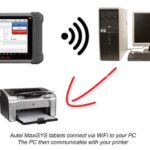A common issue encountered when using VCDS (Vag-Com Diagnostic System) is the “CAN Not Ready” error during the port test. This error indicates a problem with the Controller Area Network (CAN) bus communication, preventing the diagnostic tool from communicating with the vehicle’s control modules. This article aims to help you understand the possible causes and troubleshooting steps for this problem.
A user experiencing “CAN Not Ready” errors on a 2003 VW Touareg with a 3.2L VR6 engine encountered difficulties communicating with the vehicle’s control modules. Despite trying different Ross-Tech interfaces (HEX-USB+CAN and HEX-V2), the port test consistently showed “CAN Not Ready,” sometimes accompanied by K1 and/or K2 errors. While suspecting a wiring issue, the user requested clarification on what VCDS defines as K1 and K2 lines to facilitate troubleshooting. The vehicle’s OBD-II connector has the following wires connected:
- 1: Discretionary
- 2: Bus + Line of SAE-J1850
- 4: Chassis Ground
- 6: CAN High of SAE-J2284
- 7: K-Line of ISO-9141-2 and ISO-14230-4
- 14: CAN Low of SAE-J2284
- 16: Unswitched Battery Positive
Understanding K1 and K2 Lines in VCDS
In VCDS, K1 and K2 refer to specific communication lines used for diagnostics in older Volkswagen Group vehicles.
- K1: Represents the K-line, typically used for ISO9141-2 and ISO14230-4 (KWP2000) communication protocols.
- K2: Represents the L-line, less commonly used and often not connected in many vehicles. It is associated with the ISO9141-2 protocol.
Troubleshooting “CAN Not Ready”
A “CAN Not Ready” error indicates a breakdown in communication on the CAN bus, which is crucial for modern vehicle diagnostics. Several factors can contribute to this issue:
1. Wiring Problems:
- Damaged Wiring: Inspect the CAN High (pin 6) and CAN Low (pin 14) wires for breaks, shorts, or corrosion. A simple visual inspection or using a multimeter to check continuity can help identify issues.
- Loose Connections: Verify that the wires are securely connected to both the OBD-II connector and the respective control modules.
- Incorrect Wiring: Ensure the wiring conforms to the vehicle’s specifications.
2. Faulty OBD-II Connector:
- Damaged Pins: Check for bent or broken pins within the OBD-II connector that could be hindering communication.
- Connector Issues: The connector itself might be faulty. Try using a known good OBD-II connector or extension cable to rule out this possibility.
3. Faulty Control Modules:
A malfunctioning control module can disrupt communication on the CAN bus. Using VCDS to scan for fault codes in other modules might pinpoint the source of the problem. However, this is only possible if some level of communication can be established.
4. Blown Fuses:
Check the fuse box for any blown fuses related to the diagnostic system or the CAN bus. Consult the vehicle’s owner’s manual for fuse locations and descriptions.
5. Low Battery Voltage:
A weak battery can sometimes interfere with proper CAN bus communication. Ensure the battery is fully charged and in good condition.
6. Software Issues:
- Outdated VCDS Software: Ensure you are using the latest version of the VCDS software. Updates often include bug fixes and improved communication protocols.
- Driver Issues: Verify that the correct drivers for the Ross-Tech interface are installed on your computer.
Conclusion
Troubleshooting a “VCDS Port Test: CAN Not Ready” error requires a systematic approach. Start with the most common causes, such as wiring problems and faulty connectors, before moving on to more complex issues like faulty control modules. By carefully inspecting and testing each component, you can effectively isolate and resolve the problem, enabling successful communication with the vehicle’s control modules for diagnostics and troubleshooting.

